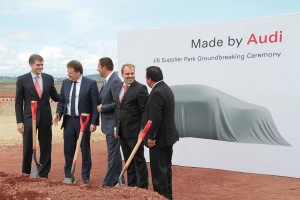
Audi's new plant in Mexico may be the last of its kind for some time, according to IHS Analyst Henner Lehne.
Unforeseen events such as the sudden collapse of oil prices and the conflict in the Ukraine have combined to re-shape the outlook for the automobile industry, according to Henner Lehne, senior director of global light vehicle forecasting, IHS.
The oil price collapse, which has garnered renewed attention this week as the price of crude oil dropped again, has begun to create clear winners and losers. The list of winners includes the United States, China, Japan and other oil importing nations, while the losers have been net exporters, such as Russia, Venezuela, Norway and sub-Saharan Africa.
Within the European Union, the falling price of oil has been more or less neutral because the decline in oil prices has been offset by the decline in the value of the euro and higher taxes used to replenish losses by governments in euro-zone. The recent shifts also mean that that the carmakers now have to depend on mature markets in North American and Western Europe.
“Russia and Brazil already are in recession,” he said. Car sales in Russia have been particularly volatile. That volatility led General Motors to basically pull out of the country, it said in an announcement earlier this week.
Before the Lehman Brothers in September 2008 and the subsequent global financial panic, sales were expected to reach 4 million. The prediction vaporized but last year sale were expect to reach 2.4 million but dropped and this year the predictions are for 1.5 million units in Russia.
Russia economy is expected to shrink by 5% this year as oil prices fall and the economic sanctions imposed by the U.S. and European Union on the hells of the fighting in the Ukraine.
Sales of electric vehicles are also being threatened, he said. With the price of oil dropping, the purchase of an electric vehicle makes “even less sense” on an economic basis, he said. However, EV sales are bolstered in places such as California by government incentives.
(Pact with Iran may open new market for automakers. For more, Click Here.)
“Buying an electric vehicle is more of philosophical statement,” he said.
The other factor re-shaping the automotive industry is that the growth of the luxury segment continues to outpace the growth of the industry as a whole over the next five years, particularly in the U.S. “There are more and more rich people in the world every year,” he said.
The luxury boom has been particularly helpful for European carmakers, particularly the “German 3,” IHS analysts said.
(Click Here for details about the latest drop in gas prices.)
Roughly 26% of the world’s luxury cars are built in Europe, noted Michael Jackson, IHS senior manager of North American production forecasting. By contract, approximately 9% come from North America and less than 5% are built in China.
Production of new vehicles in North America has nearly doubled since 2009. Currently 50% of the plants in the U.S., Canada and Mexico are operating with three shifts, which means the industry probably won’t face the big restructuring issues that became acute as far back as the early 1970s and continued right up until the last recession.
(To see why vehicles getting less than 20 mpg are on the decline, Click Here.)
Carmakers are continuing to look for ways to expand production in North America, Jackson said. But one hot spot, Mexico, which has been attractive for a number of reasons, such as its varied free trade agreements 40 different countries, could attract less investment.
One reason why is the capacity of local governments in places such as San Luis Potosi where Audi is building a new plant has been pretty much exhausted at this point. “They don’t have any more money,” Jackson said.

Building in Mexico is a very, very risky and expensive program, as many companies have found out the hard way. The low upfront costs are offset by the expensive training and lack of skilled workers, not to mention inflation rates of up to a hundred percent or more annually.